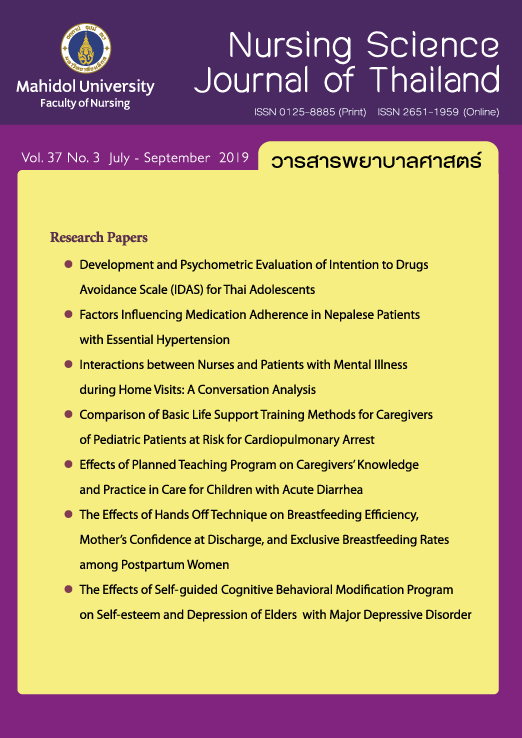The Effects of Hands Off Technique on Breastfeeding Efficiency, Mother’s Confidence at Discharge, and Exclusive Breastfeeding Rates among Postpartum Women
Main Article Content
Abstract
Purpose: This study aimed to compare breastfeeding efficiency, mother’s confidence before discharge and breastfeeding rates among postpartum mothers who were taught using hands off and non-hands off techniques.
Design: Quasi-experimental design.
Methods: The sample comprised of postpartum mothers aged 18 years and older with normal delivery, no complication, and intention of breastfeeding. The sample was divided into control and experimental groups with 57 mothers each. The experimental group had been educated in positioning breastfeeding using hands off technique while the control group received routine care using non-hands off technique. Data were collected using LATCH score, breastfeeding confidence questionnaire, and telephone call follow-up for breastfeeding rate. Data were analyzed using ANCOVA, chi-square test, and Fisher’s exact test.
Main findings: Before being discharges, mothers in the experimental group had higher breastfeeding confidence score than that in the control group (F = 53.258, p < .001). However, breastfeeding efficiency before discharge using LATCH score and breastfeeding rates at 7 days, 1 month, 2 months, and 6 months were not different at level of significance .05.
Conclusion and recommendations: Educating mothers about positioning breastfeeding using hands off technique could induce mothers’ breastfeeding confidence. Nurses should demonstrate and have the mothers return the demonstrations of positioning breastfeeding at the initial phase post delivery. This could help mothers to become confident to breastfeed their babies at home.
Article Details
Copyright Notice: Nursing Science Journal of Thailand has exclusive rights to publish and distribute the manuscript and all contents therein. Without the journal’s permission, the dissemination of the manuscript in another journal or online, and the reproduction of the manuscript for non-educational purpose are prohibited.

Disclaimer: The opinion expressed and figures provided in this journal, NSJT, are the sole responsibility of the authors. The editorial board bears no responsibility in this regard.
References
2. Apichatvorapong C. The relationship between stress and its related factors influencing exclusive breastfeeding among working mothers [master’ thesis]. Bangkok; Mahidol University; 2004. 130 p. (in Thai).
3. Jintrawet U, Tongsawas T, Somboon L. Factors associated with the duration of exclusive breastfeeding among postpartum mothers. Nursing Journal. 2014;41(1):133-44. (in Thai).
4. Gale J, Fothergill-Bourbonnais F, Chamberlain M. Measuring nursing support during childbirth. MCN Am J Matern Child Nurs. 2001;26(5):264-71.
5. Nuampa S, Sinsuksai N, Phahuwatanakorn W, Chanprapaph P. Personal factors, first feeding time and nurse support in predicting successful exclusive breastfeeding at discharge in mothers with cesarean section. Journal of Nursing Science. 2013;31(2):49-59. (in Thai).
6. Chisuwan C, Prasopkitikun T, Sangperm P, Payakkaraung. Predictive power of support from husbands grandmothers and nurses on duration of exclusive breastfeeding. Journal of Nursing Science. 2012;30(1):70-80. (in Thai).
7. Leahy-Warren P. First-time mothers: social support and confidence in infant care. J Adv Nurs. 2005;50(5):479-88.
8. Weimers L, Svensson K, Dumas L, Navér L, Wahlberg V. Hands-on approach during breastfeeding support in a neonatal intensive care unit: a qualitative study of Swedish mothers' experiences. Int Breastfeed J. 2006;1:20. doi:10.1186/1746-4358-1-20.
9. Azhari S, Baghani R, Akhlaghi F, Ebrahimzadeh S, Salehi J. Comparing the effects of hands-on and hands-off breastfeeding methods on self-efficacy in primiparous mothers. Journal of Sabzevar University of Medical Sciences. 2011;17(4):248-55.
10. Baghany R, Azhari S, Akhlaghi F, Tabaraei Y, Shokrollahi MR. Comparing the effects of “hands-on” and “hands-off” educational techniques on exclusive breastfeeding among primiparous mothers. Life Sci J. 2013;10(12s):202-7.
11. Ngamjarus C, Chongsuvivatwong V. n4Studies: iPhone application [computer program]. Version 1.1.0: The Royal Golden Jubilee Ph.D. Program - The Thailand Research Fund and Prince of Songkla University; 2014.
12. Puapornpong P, Raungrongmorakot K, Hamontri S, Ketsuwan S, Wongin S. Latch score and exclusive breastfeeding during the first six months postpartum. Journal of Medicine and Health Sciences. 2016;23(1):8-14. (in Thai).
13. Janjornmanit B, Kantaruksa K, Sriarporn P. Effect of teaching using hands off technique on successful exclusive breastfeeding among primiparous mothers. Nursing Journal. 2015;42(3):24-36. (in Thai).


